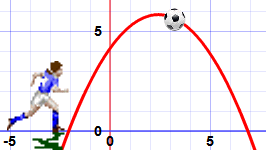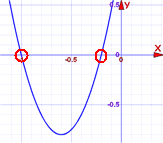Quadratic Formula | द्विघात समीकरण | Quadratic Equation Tricks | How To Solve Quadratic Equations
Youtube Video: Quadratic Formula
An example of a Quadratic Equation:
The function makes nice curves like this one:
Name
The name Quadratic comes from "quad" meaning square, because the variable gets squared (like x2).
It is also called an "Equation of Degree 2" (because of the "2" on the x)
Youtube Video: Quadratic Formula
Standard Form
The Standard Form of a Quadratic Equation looks like this:
- a, b and c are known values. a can't be 0.
- "x" is the variable or unknown (we don't know it yet).
Here are some examples:
| 2x2 + 5x + 3 = 0 | In this one a=2, b=5 and c=3 | |
| x2 − 3x = 0 | This one is a little more tricky:
| |
| 5x − 3 = 0 | Oops! This one is not a quadratic equation: it is missing x2 (in other words a=0, which means it can't be quadratic) Youtube Video: Quadratic FormulaHidden Quadratic Equations!As we saw before, the Standard Form of a Quadratic Equation is ax2 + bx + c = 0 But sometimes a quadratic equation doesn't look like that! For example: |
About the Quadratic Formula
Plus/Minus
First of all what is that plus/minus thing that looks like ± ?
The ± means there are TWO answers:
x = −b + √(b2 − 4ac)2a
x = −b − √(b2 − 4ac)2a
Here is an example with two answers:
But it does not always work out like that!
- Imagine if the curve "just touches" the x-axis.
- Or imagine the curve is so high it doesn't even cross the x-axis!
This is where the "Discriminant" helps us ...
Youtube Video: Quadratic Formula
Discriminant
Do you see b2 − 4ac in the formula above? It is called the Discriminant, because it can "discriminate" between the possible types of answer:
Complex solutions? Let's talk about them after we see how to use the formula.
Youtube Video: Quadratic Formula
Using the Quadratic Formula
Just put the values of a, b and c into the Quadratic Formula, and do the calculations.










No comments:
Post a Comment
Please do not paste any url....